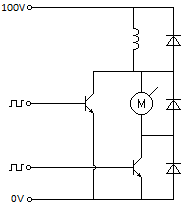Hi folks,
Sorry if this has been discussed already, I was unable to find it.
I am now considering of using a series-wound DC motor on enduro motorcycle, because of it's "infinite" top speed. Of cause the problem is to implement a regen capability, because the motor does not have a permanent magnet.
I've dome some searches and found out that it is "doable" but is "very complex". I've also found some "production" controller assemblies with integrated heavy duty contactors. Well, this is not the way I'd like to go. I am electronics engineer and believe that such capability should be possible to implement in more intellectual way. I.e. transistors.
In modern systems regeneration is done with a boost converter, which is using motor's internal inductivity. So I haven't put a lot of thought into it and came up with this schematic:

In this schematic the motor represents series-wound DC motor's rotor and the inductor represents it's stator (electromagnet).
In normal operation only lower transistor is used (PWM). In regen, both transistors are PWM'ed simultaneously: both of them are opened at the same time, this means field winding is being energized and the rotor is shorted for some time and when both transistors are switched off, a self-induction of the motor spikes a current back to the battery through upper diode.
Of cause I haven't thought all of it through and there may be (and I'm sure there is) some problems with the design. For example, battery power is being used to energize the stator.
Any comments from specialists are highly appreciated. Also, please give me some links to any technical material to study.
Sorry if this has been discussed already, I was unable to find it.
I am now considering of using a series-wound DC motor on enduro motorcycle, because of it's "infinite" top speed. Of cause the problem is to implement a regen capability, because the motor does not have a permanent magnet.
I've dome some searches and found out that it is "doable" but is "very complex". I've also found some "production" controller assemblies with integrated heavy duty contactors. Well, this is not the way I'd like to go. I am electronics engineer and believe that such capability should be possible to implement in more intellectual way. I.e. transistors.
In modern systems regeneration is done with a boost converter, which is using motor's internal inductivity. So I haven't put a lot of thought into it and came up with this schematic:

In this schematic the motor represents series-wound DC motor's rotor and the inductor represents it's stator (electromagnet).
In normal operation only lower transistor is used (PWM). In regen, both transistors are PWM'ed simultaneously: both of them are opened at the same time, this means field winding is being energized and the rotor is shorted for some time and when both transistors are switched off, a self-induction of the motor spikes a current back to the battery through upper diode.
Of cause I haven't thought all of it through and there may be (and I'm sure there is) some problems with the design. For example, battery power is being used to energize the stator.
Any comments from specialists are highly appreciated. Also, please give me some links to any technical material to study.

